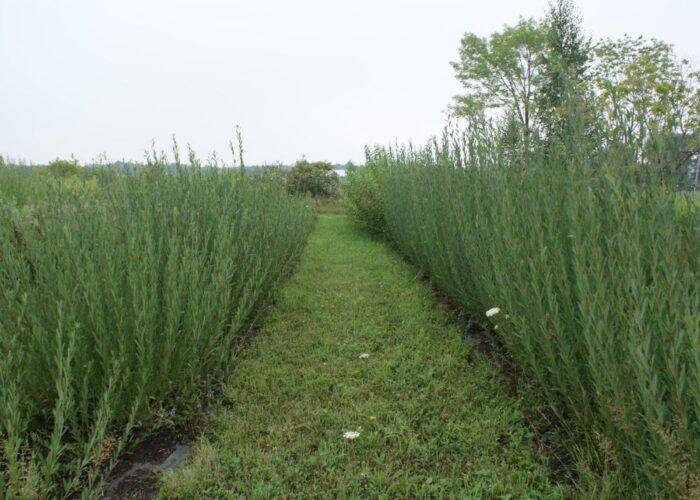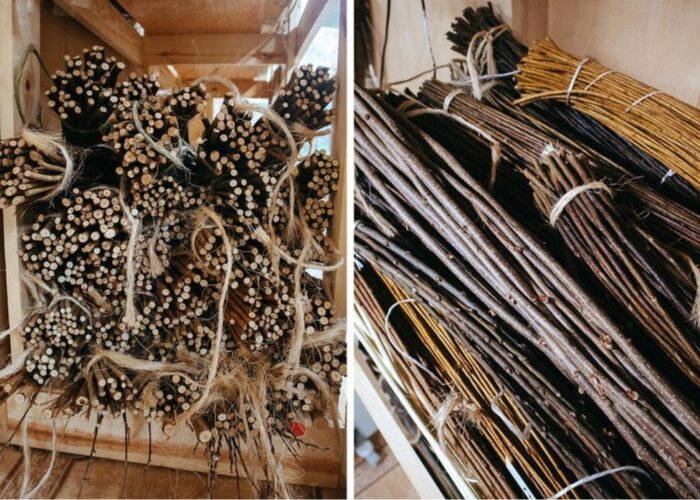Willow has long been cherished as a prime material for crafting handmade products, with willow weaving gaining popularity for its natural beauty and versatility. The art of weaving with willow, particularly the Salix viminalis or basket willow, has become a sought-after skill, producing textiles that seamlessly blend tradition and contemporary design.
In this exploration of how to grow willow for weaving, let’s embark on a journey to uncover the intricacies of cultivating and harvesting basket willow, the coveted source for crafting exquisite woven fabrics. Let’s explore!
Contents [hide]
- 1. How to grow willow for weaving?
- Step 1: Selecting the right willow variety
- Step 2: Choosing an optimal location
- Step 3: Preparing the planting site
- Step 4: Obtaining willow cuttings
- Step 5: Planting willow cuttings
- Step 6: Watering and maintenance
- Step 7: Pruning for growth and shape
- Step 8: Harvesting willow for weaving
- Step 9: Drying and storing
- 2. How to harvest willow for weaving?
- 2. FAQs
- 3. Final thought
1. How to grow willow for weaving?
To embark on the journey of growing willow for weaving, you’ll need several materials to ensure a successful and sustainable cultivation process. Here’s a list of essential materials:
Materials Needed:
- Willow cuttings;
- Watering tools;
- Pruning tools;
- Storage containers.
Step by step:
Step 1: Selecting the right willow variety
Begin by choosing a willow variety suitable for weaving. Salix viminalis and Salix triandra are popular choices due to their flexible and robust branches.

Step 2: Choosing an optimal location
Willows thrive in moist environments with well-draining soil and plenty of sunlight. Select a location near a water source and ensure there is enough space for the willow to grow.
Step 3: Preparing the planting site
Prepare the soil by removing weeds and adding organic matter. Willows prefer slightly acidic to neutral soil. Create furrows or holes for planting the cuttings.
Step 4: Obtaining willow cuttings
Acquire healthy willow cuttings during the dormant season. Cuttings should be around 8-12 inches in length, with several buds present.
Step 5: Planting willow cuttings
Plant the cuttings in the prepared soil, ensuring they are inserted about 6-8 inches deep with a few buds above the surface. Space the cuttings adequately to allow for healthy growth.
Step 6: Watering and maintenance
Keep the soil consistently moist, especially during the initial stages of growth. Mulch around the base of the plants to retain moisture and suppress weeds.
Step 7: Pruning for growth and shape
Prune the willow during the dormant season to encourage branching and shape the plant according to your preferences. Pruning helps create a denser and more flexible growth.
Step 8: Harvesting willow for weaving
Harvest the willow when it reaches the desired height, typically after two to three years. Cut the branches at the base during the dormant season to ensure a sustainable and regenerative harvest.
Step 9: Drying and storing
Allow the harvested branches to dry in a cool, dry place for a few weeks. Once dried, store the branches in a well-ventilated area until ready for use in weaving projects.
By following these steps, you not only cultivate a renewable source of willow for weaving but also foster a deep connection with the natural world. The sustainable practice of growing willow for weaving ensures a continuous supply of materials for your artistic endeavors, creating a beautiful synergy between nature and craftsmanship.
2. How to harvest willow for weaving?
Harvesting willow for weaving is a pivotal step in the process, as it determines the quality and abundance of material for your creative endeavors. Here’s a comprehensive guide on how to harvest willow for weaving:
- Timing is Key: Harvest willow during the dormant season, typically in late winter or early spring before the new growth begins. This ensures that the plant is in a state of rest, making it easier to handle and encouraging regrowth.
- Choose the Right Age: Opt for mature willow branches that have reached the desired height, usually after two to three years of growth. Harvesting too early may result in underdeveloped branches, while waiting too long might lead to overly thick and less flexible stems.
- Use Sharp Pruning Tools: Employ sharp pruning shears or loppers to make clean cuts. This minimizes damage to the plant and promotes healthy regrowth. Sterilize your cutting tools to prevent the spread of diseases.
- Cut at the Base: Position your pruning tools at the base of the branch, close to the main stem, and make a smooth cut. Avoid leaving stubs, as they can be prone to disease, and ensure that the cut is clean and even.

- Selective Harvesting: Choose branches strategically, considering your weaving needs. Select branches with the right thickness, length, and flexibility for your specific projects. This selective approach allows for a more purposeful harvest.
- Leave Young Shoots: Leave some young shoots and branches on the plant during the harvest. This promotes healthy regrowth and ensures a sustainable supply of willow for future weaving projects.
- Handle with Care: Treat harvested branches gently to avoid damage. Bundle them together and transport them carefully to the drying or processing area. Willow branches are flexible but can be susceptible to breakage if mishandled.

- Dry in a Well-Ventilated Area: Once harvested, allow the branches to dry in a cool, well-ventilated area for a few weeks. This drying period helps reduce moisture content, making the branches more pliable for weaving.

- Storage: After drying, store the harvested willow in a cool, dry place with good airflow. Proper storage prevents mold and maintains the quality of the weaving material until you are ready to use it.
Mastering the art of harvesting willow for weaving is a skill that enhances the sustainability of your craft. By following these steps, you ensure a thoughtful and regenerative approach to obtaining the raw materials for your weaving projects, connecting you more deeply with the natural cycle of the willow plant.
2. FAQs
2.1 How long does it take to grow willow for weaving?
Growing willow for weaving usually takes approximately two to three years before the branches are mature enough for harvest.
2.2 Which willow is best for weaving?
The best willow for weaving is often Salix viminalis, commonly known as basket willow. It has long, flexible branches that are well-suited for weaving projects. Other willow varieties, such as Salix purpurea (purple willow) and Salix triandra (black maul willow), are also popular choices for weaving due to their pliability and attractive colors.
2.3 Can you plant willow cuttings straight into the ground?
Yes, you can plant willow cuttings directly into the ground. Choose healthy, 8 to 12-inch cuttings and bury them in well-drained, moist soil. Space them 18 to 24 inches apart, keep the soil consistently moist, and protect them until they establish roots, usually within a few weeks to a couple of months.
2.4 How much space do you need to grow willow?
The space needed to grow willow depends on the specific variety and purpose. Generally, willows are adaptable and can be grown in a variety of spaces. For ornamental or smaller varieties, you can plant willows in spaces as small as 6 to 8 feet apart. If you are growing willow for biomass or larger timber, you might space them more widely, around 12 to 15 feet apart.
It’s important to consider the mature size of the specific willow species and the purpose of cultivation when determining the spacing between plants.
3. Final thought
In summary, growing willow for weaving is a meticulous yet rewarding process that blends nature and craftsmanship seamlessly. By selecting the right variety, nurturing it with care, and harvesting thoughtfully, artisans ensure a sustainable and renewable source of materials.
If you have any further questions, don’t hesitate to send us an email us at info@thanhcongcraft.com or message us at WhatsApp: +84967485411. Hope to serve you soon! Best regard!


